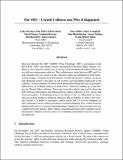The MIT – Cornell Collision and Why It Happened
Author(s)
Fletcher, Luke Sebastian; Teller, Seth; Olson, Edwin B.; Moore, David C.; Kuwata, Yoshiaki; How, Jonathan P.; Leonard, John Joseph; Miller, Isaac; Campbell, Mark; Huttenlocher, Dan; Nathan, Aaron; Kline, Frank-Robert; ... Show more Show less
DownloadMain article (14.00Mb)
OPEN_ACCESS_POLICY
Open Access Policy
Creative Commons Attribution-Noncommercial-Share Alike
Terms of use
Metadata
Show full item recordAbstract
Mid-way through the 2007 DARPA Urban Challenge, MIT’s autonomous Land
Rover LR3 ‘Talos’ and Team Cornell’s autonomous Chevrolet Tahoe ‘Skynet’ collided
in a low-speed accident, one of the first well-documented collisions between
two full-size autonomous vehicles. This collaborative study between MIT and Cornell
examines the root causes of the collision, which are identified in both teams’
system designs. Systems-level descriptions of both autonomous vehicles are given,
and additional detail is provided on sub-systems and algorithms implicated in the
collision. A brief summary of robot–robot interactions during the race is presented,
followed by an in-depth analysis of both robots’ behaviors leading up to and during
the Skynet–Talos collision. Data logs from the vehicles are used to show the
gulf between autonomous and human-driven vehicle behavior at low speeds and
close proximities. Contributing factors are shown to be: (1) difficulties in sensor
data association leading to phantom obstacles and an inability to detect slow moving
vehicles, (2) failure to anticipate vehicle intent, and (3) an over emphasis on
lane constraints versus vehicle proximity in motion planning. Eye contact between
human road users is a crucial communications channel for slow-moving close encounters
between vehicles. Inter-vehicle communication may play a similar role for
autonomous vehicles; however, there are availability and denial-of-service issues to
be addressed.
Date issued
2009-11Department
Massachusetts Institute of Technology. Department of Aeronautics and Astronautics; Massachusetts Institute of Technology. Department of Electrical Engineering and Computer ScienceJournal
Springer Tracts in Advanced Robotics : The DARPA Urban Challenge Autonomous Vehicles in City Traffic
Publisher
Springer Berlin / Heidleberg
Citation
Fletcher, Luke et al. “The MIT – Cornell Collision and Why It Happened.” The DARPA Urban Challenge. Springer Berlin / Heidelberg, 2009. 509-548.
Version: Author's final manuscript
ISBN
978-3-642-03990-4
ISSN
1610-7438
1610-742X